- To bridge the gender and minority gap in radiology, University of Chicago radiologists developed a free expo to promote the field to women and underrepresented minorities.
- Medical students indicate that the event gave them an increased understanding of the field of radiology.
- In 2020, the event transitioned to a virtual platform, reaching students across the U.S. and around the world.
“Radiology isn’t really integrated into the curriculum in many medical programs,” Dinh says. “Many people don’t have a good understanding of what radiologists do, and medical students, including myself, often believe the stereotype that radiologists sit in a dark room and don’t have interaction with patients. It didn’t seem like something I wanted to pursue.”
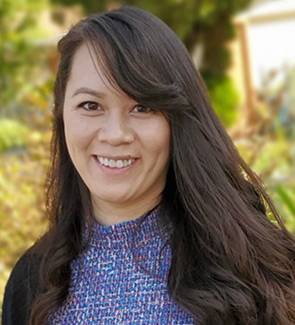 Annie N. Dinh, MD, second-year radiology resident, decided to specialize in radiology after attending the Radiology Expo. |
Since 2016, the Radiology Expo, now called the Chicagoland Radiology Expo , has reached hundreds of medical students, both nationally and internationally, and has helped encourage many medical students to pursue careers in radiology. Originally hosted by the University of Chicago’s Department of Radiology Diversity & Inclusion Council , the expo is a free, hands-on experience designed to introduce medical students to radiology and radiation oncology and to encourage more women and people who are traditionally considered underrepresented minorities (URM) in particular to join the specialty.
Increasing Diversity
According to the ACR 2019 Diversity Report , nearly half of all medical students in the U.S. are women, but women represent only about 29% of radiology faculty. People who are considered URMs represent 15.3% of medical school graduates, but they account for only 6.5% of diagnostic radiologists and 7.2% of radiation oncologists.1 This is a problem for multiple reasons, says Johnson B. Lightfoote, MD, MBA, FACR, chair of the ACR Commission for Women and Diversity, not the least of which is suboptimal patient care. “People who come from a particular community are more likely to understand the perspectives of patients who look and think like they do,” he says. “Radiology is not just a technical specialty; it is a service specialty. We have to concentrate on what patients need because we are serving them, and we need diverse representation to accomplish that mission.”Part of the problem, emphasizes Lightfoote, is that students have limited exposure to the field. “Radiology is offered as a late elective in most medical schools,” he says, “and many minorities go to schools that lack radiology residency programs. Therefore, women and minorities learn about the radiology field too late to get their applications together, so many do not apply.”
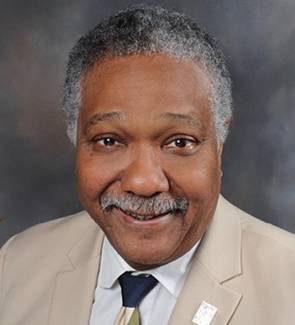 Johnson B. Lightfoote, MD, MBA, FACR, chair of the ACR Commission for Women and Diversity, hopes to increase medical students’ exposure to radiology. |
Getting Started
With this in mind, Yang, Lu, and the Diversity & Inclusion Council organized a lunch and learn in 2015 called “Radiology Residency: Where Are the Women?” and emailed invitations to the event to all four of the medical school classes within the University of Chicago’s Pritzker School of Medicine. Approximately 60 medical students attended the event.At the luncheon’s start, attendees completed a pre-event survey to gauge their understanding of radiology and their hesitation about joining the specialty. Many of the students who attended expressed concerns about the lack of patient contact and isolation from other clinicians. “We hear a lot of misconceptions — that radiologists are isolated in a reading room and don’t talk to anyone,” says Yang, who also serves as director of the neuroradiology fellow-ship and director of pediatric neuroradiology at the University of Chicago. “We wanted to dispel that myth by discussing our experiences and motivations for being in the field.”
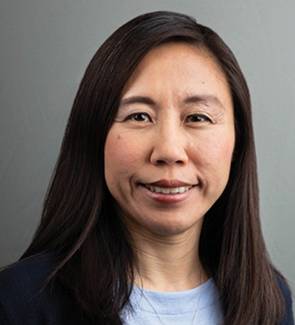 Carina W. Yang, MD, director of the neuroradiology fellowship and director of pediatric neuroradiology at the University of Chicago, co-chaired the first Radiology Expo. |
At the end of the program, attendees completed a post-event survey to see whether their perceptions of radiology had changed. The results revealed that not only did the event allay participants’ concerns about patient interaction, but it also familiarized them with radiology in general. “The impact it made inspired us to put our heads together for a bigger event that would allow us to engage students from all over Chicagoland,” Yang says. (Chicagoland is name for the Chicago metropolitan area, spanning parts of Illinois, Indiana, and Wisconsin.)
With the idea to expand the event, Yang partnered with Kirti M. Kulkarni, MD, associate professor of radiology at the University of Chicago, to co-chair the first Radiology Expo. “We realized we needed to do something on a bigger scale to attract more students,” Kulkarni says. “In particular, we wanted to host talks and learning opportunities that catered to women and underrepresented minorities. We as women in science and leadership roles owe it to one another. This was another venue for us to strengthen the pipeline and share what radiology has to offer.”
Planning the Expo
The committee applied for and received a $1,000 grant from the University of Chicago’s Biological Sciences Diversity and Inclusion Committee to finance the expo. The university’s radiology department believed in the expo and its goals and offered to fund the remaining cost of $4,000. With this funding, the group rented several rooms on campus, covered the keynote speaker’s travel expenses and honorarium, purchased raffle prizes, and paid for marketing.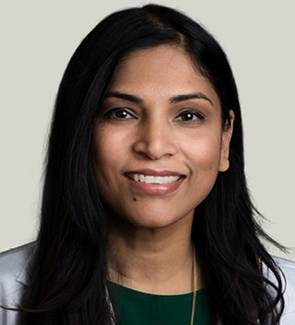 Kirti M. Kulkarni, MD, associate professor of radiology at the University of Chicago, co-chaired the first Radiology Expo. |
The event took place on Nov. 5, 2016, in conjunction with the International Day of Radiology , a day commemorating Wilhelm Conrad Röntgen’s X-ray discovery. Etta D. Pisano, MD, ACR chief research officer and professor in residence at Harvard Medical School, gave a keynote address called “Professional Climate for Women in Radiology,” and breakout sessions focused on life as a radiologist, the future of radiology, program application advice, and other topics.
Students had the opportunity to meet current and former radiology program directors through one-on-one speed advising sessions. They also participated in interactive exhibits that took them through biopsy procedures and ultrasound scans using models and imaging equipment. And they had an opportunity to solve a mystery case study or participate in a game show for a chance at a raffle prize.
In the same spirit as the luncheon, the expo sought to foster connections between practicing radiologists and medical students. Dinh felt encouraged to ask questions and engage with the speakers. “We spend so much of our time trying to impress the attending or resident we are working with,” she says. “It was nice to be in an environment where I felt relaxed enough to ask basic questions about the field.”
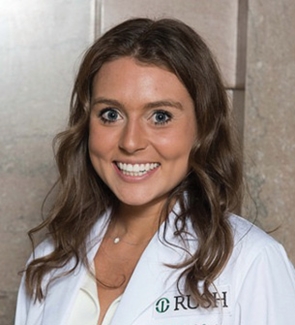 After attending the expo, Katie L. Hughes, MD, first-year diagnostic radiology resident, was inspired to become a radiologist. |
Forming a Partnership
Following the first event’s success, the committee immediately made plans to host the expo annually. The first step was to form the Chicagoland Radiology Expo Planning Committee to help focus and increase its efforts on the event. This task force knew it needed to increase its fundraising efforts, so Kulkarni and Yang approached the Chicago Radiological Society , a local chapter of the ACR, with hopes of securing a partnership.“We emphasized how we wanted to bridge the diversity gap and inspire medical students in the Chicagoland area,” Kulkarni says. “We have to make an effort to break down all barriers as well as the misconceptions about radiology to ensure students understand our patient-centered role and that women and minorities can and should be a part of that.”
At the time, the Chicago Radiological Society’s outgoing president Bojan Petrovic, MD, assumed the role of expo director. Petrovic, who was an expo panelist in 2017, was invested in the expo and helped build a bridge between the two groups. As a result, the Chicago Radiological Society was immediately interested in supporting the expo and agreed to partner with the Diversity & Inclusion Council to sponsor refreshments, provide volunteers, and promote the event to its members. This partnership also highlighted the focus on the entire Chicago area, so the planning committee changed the program’s name to the Chicagoland Radiology Expo.
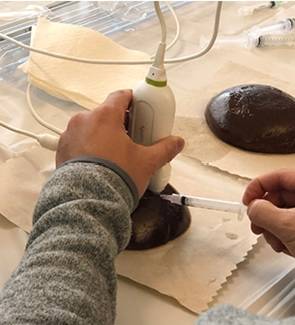 The Radiology Expo includes hands-on learning activities, such as using ultrasound on models, to give participants a clear understanding of what it means to be a radiologist. |
In 2019, the ACR Commission for Women and Diversity joined in to sponsor the expo, which was recognized as a high-impact project during the ACR Annual Meeting for its success in exposing medical students to radiology with a focus on increasing diversity.
“We need to do a better job at recruiting and retaining professionals in radiology,” says Lightfoote, medical director of the department of radiology at Pomona Valley Hospital Medical Center. “Success in radiology is not a choice between diversity or excellence; it is excellence through diversity. It is important not only for minorities but for non-minorities to see minorities as excellent contributors in the field. To know and understand that women and minorities can be in charge of a program and enhance the excellence is incredibly important to the future of radiology. Reaching students early through events like the Chicagoland Radiology Expo aligns perfectly with the goals of the commission.”
Going Virtual
The expo continued to gain success. When COVID-19 began to threaten the U.S., the planning process for the 2020 expo had just begun. Faced with a decision to cancel the event or pivot to a virtual platform, the planning committee unanimously agreed to host the event virtually.“Because we could reach more students and we had never used a digital platform for the event, this was our most ambitious year. We were nervous but excited about these opportunities,” Yang says. “Without geographical limitations, we blanketed medical schools and residency programs in every state with digital promotional flyers. In fact, when I interviewed medical students this year from all over the country, they had all heard about our expo.” The planning committee also heavily promoted the event on social media.
Knowing that developing the virtual platform would require more funding than in years prior, Kulkarni created a tiered sponsorship package. Sponsors could support at the silver, gold, and platinum levels. Silver status required a $1,000 sponsorship and included publicity for the sponsor on all expo marketing material, company logo on expo video presentations, and linked vendor sponsor pages on the expo website. Gold status required a $3,000 sponsorship and also included an optional live sponsor video session in the digital expo hall. Platinum status required a $5,000 sponsorship and also offered to play the sponsor’s video prior to the keynote session.
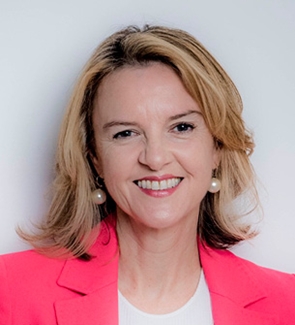 Geraldine B. McGinty, MD, MBA, FACR, who delivered closing remarks during the 2020 Radiology Expo, says diversity among radiologists is critical to serving the diverse needs of patients. |
The Chicagoland Radiology Expo virtual experience was held on Nov. 14, 2020. Over 500 people registered for the virtual event, 10% of whom were international students. The website garnered nearly 2,000 hits, with 60% of those visits occurring the day of the event. Expo content is recorded and available on the expo website.
In addition to the regular expo content, the planning committee added a combination of live and pre-recorded talks from many other areas of radiology, including artificial intelligence, neuroradiology, pediatric interventional radiology, and molecular imaging. It also created a virtual expo hall that allowed vendors to set up digital booths. “We were able to offer more content than ever before because we could offer so much synchronously,” Kulkarni explains.
Even though the planning committee was unable to simulate the hands-on experience of reading images using the picture archiving and communications system, the group created an interactive Q&A that allowed students to observe as residents and radiology faculty read anonymized case studies. During this live session, students could report about what they saw and receive feedback from the residents.
Participants were enthusiastic and grateful for the event. One participant tweeted: “Thank you Dr. Birch for taking [sic] about INTENTIONAL recruitment of URM candidates and the positively wonderful downstream effects!”2 An-other participant was inspired by keynote speaker Richard B. Gunderman, MD, and tweeted, “An inspiring reminder of our history, the amazing work and dedication of Marie Curie, and how far we have come and will continue to progress!”3
Excellence Through Diversity
In 2021, the University of Chicago’s Chicagoland Radiology Expo Planning Committee plans to again host the event virtually to maintain COVID-19-safe practices and to reach as many students as possible. As it continues to plan for the future, the planning committee remains grounded in its commitment to diversity and medical student education — two areas that former ACR President Geraldine B. McGinty, MD, MBA, FACR, says are critical to the specialty’s future.“When we don’t have radiologists with diverse backgrounds, we are not going to be as well positioned to develop work plans and pathways of care to best serve our diverse patient communities,” says McGinty, who delivered the closing remarks at the 2020 expo. “If we are going to provide the best care, we have to have a diverse healthcare workforce. Events like this help expose more students to radiology, which opens the doors to diversifying the specialty.”
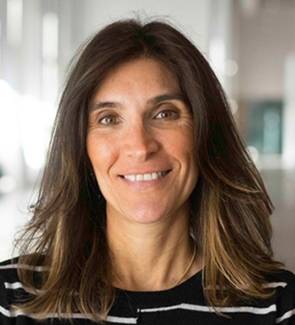 Nina Kottler, MD, MS, associate chief medical officer for clinical artificial intelligence at Radiology Partners, was a keynote speaker at the 2019 Radiology Expo. |
Hearing from McGinty, Kottler, and other women in leadership roles at the expo also inspired Dinh and Hughes. “With any specialty, when you have support from leaders of the same gender, it makes such a difference,” Dinh says. “Women face so much pressure to be the primary family caretaker as well as to have a professional career. When you see other women who went before you balancing those expectations, it just makes you feel like you can succeed.”
Looking Ahead
As the planning committee looks ahead, it hopes to grow and expand the expo into other communities across the nation and around the globe. “This is our investment in the future of the field,” Yang says. “We want the best of the best, and we need a diverse group of students to enter the field of radiology. The rate of women choosing radiology hasn’t increased in nearly two decades. Something needs to change.”4To expand the pipeline of underrepresented minorities and women entering the radiological professions, Yang says that it is important to consider ways to help engage medical students early in their medical education journeys. She encourages all radiologists to join in efforts to spread the word about the benefits of the specialty. “Get involved with community outreach,” says Yang, who also spends her time offering radiology educational sessions to fifth graders to introduce them to the field. “It is never too early. Start small and local. The key is to give those without exposure to radiology the opportunity to learn.”
Students like Dinh and Hughes remain grateful that the Chicagoland Radiology Expo offered them these opportunities. “The expo was a stepping-stone,” says Dinh. “I had no interest in radiology before I attended the event. I was just going on a trip with my friends. Look at me now: I’m on my way to becoming a radiologist. The expo empowered me as a female and encouraged me down the path that will challenge and encourage me. For me, it was the opportunity that changed my life.”
End Notes
1. Lightfoote JB, Fielding JR, Deville C, Gunderman RB, Morgan GN, Pandharipande PV, Duerinckx AJ, Wynn RB, Macura KJ. Improving diversity, inclusion, and representation in radiology and radiation oncology part 1: why these matter. J Am Coll Radiol. 2014; 673-680. doi: 10.1016/j.jacr.2014.03.007
2. @AdlaiGrayson. Thank you Dr. Birch for taking about INTENTIONAL recruitment of URM candidates and the positively wonderful downstream effects! #RadExpo2020 @ChicagoRadExpo #BlackMedTwitter #GayMedTwitter #FutureRadRes. https://twitter.com/AdlaiGrayson/status/1327694408192569344 . Posted Nov 14, 2020.
3. @SeungkyuPark_. An inspiring reminder of our history, the amazing work and dedication of Marie Curie, and how far we have come and will continue to progress! #RadExpo2020 Thank you Dr. Richard Gunderman. https://twitter.com/SeungkyuPark_/status/1327646381952135174 . Posted Nov 14, 2020.
4. Angtuaco TL, Macura KJ, Lewicki AM, et. al. The American Association for Women Radiologists (AAWR): 25 years of promoting women in radiology. Radiographics. 2008; 28:573–582. doi.org/10.1148/rg.282075132
Share Your Story
Have a case study idea you’d like to share with the radiology community? To submit your idea please click here.
Creative Commons
Introducing Medical Students to Radiology by American College of Radiology is licensed under a Creative Commons Attribution-NonCommercial-NoDerivatives 4.0 International License. Based on a work at www.acr.org/imaging 3. Permissions beyond the scope of this license may be available at www.acr.org/Legal.Now It's Your Turn
Follow these steps to engage future radiologists, and tell us how you did at imaging3@acr.org or on Twitter with the hashtag #Imaging3.
- Get involved with the Chicagoland Radiology Expo by volunteering and/or promoting the event to medical students in your area.
- Consider ways to expand the pipeline early (high school, college, or medical school) in your community. Start small by organizing a luncheon to promote radiology education to women and minorities.
- Get involved with diversity initiatives in your area. Consider using ACR’s Diversity Toolkit as a starting point.
Author
Chelsea Krieg, freelance writer
Join the Discussion

#Imaging3 on Twitter
Call for Case Studies
